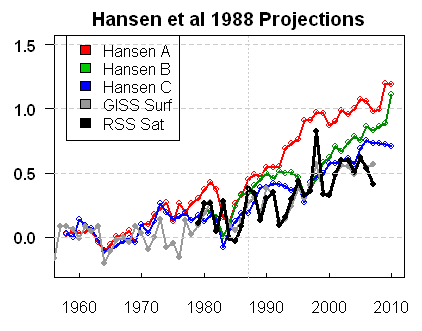Food for Tamino
While looking at the various curves and swerves on CA Eli was impressed with how well the year to year changes in temperature anomalies between the GISS ocean atmosphere record and RSS followed each other until 2007. Indeed this was a clear tip off that the RSS 2007 or the GISS 2007 values were wrong.
 So he decided that it would be sensible to plot the various series against each other
So he decided that it would be sensible to plot the various series against each other

This lead the bunny to some interesting conclusions. If there are errors in the satellite reconstructions, a place to look might be 1995 1985 [thanks to Alocacoce for the correction] and 2003, where the RSS and UAH records diverge. Eli would be somewhat more suspicious of the UAH record because both of the GISS anomalies vary as the RSS record. Also, the GISS Ocean Land anomaly in 1997 appears to rise more than all of the other records.
Because the MSUs are subject to long term drifts, this agreement of the yearly variations appears to be a decent first order check. We can add the Hadley Center global temperature anomaly to the comparison (warning, symbols change)

UPDATE: Upon awakening some thoughts.
1. RSS and UAH use the same data from the same instruments. GISS and HadCRU use in different ways and combinations the same sets of measurements. Above, Eli has shown that interannual comparison is a good way to check changes in algorithms, particularly for GISS, UAH and RSS.
2. As Rabett Holmes would say, the failure of McIntyre and Motl not to graph UAH was the dog that needed to go for a walk in the night. If UAH was plotted, (see top graph)
a. Their arguments would have been weaker3. Understanding the differences in interannual variability between HadCRU and the other sets is potentially important, not only on the annual level, but also seasonal and geographically. For example, in HadCRU looking at 1996, 7 and 8, it looks like more of the El Nino was captured in 1998 than in the other records. (Eli used J-D for the year in all the others, HadCRU may be using D-N??). There is also a lot less variability in HadCRU overall.
b. It would have been clear that there was something amiss with RSS v3.0
c. This is the sort of thing you try and teach your students, there is no such thing as a negative volume. If that is your answer, you have made an arithmetic error
4. We can perhaps use the variability (to some extent) to estimate the difference in climate sensitivity at the surface and in the lower troposphere. For example if we ratio the differences in the global temperature anomalies between 1998 and 1996 for UAH and GISS Ocean Land we get .49/.27. for the GISS surface stations it is .49/.33. Similar trends appear to hold at other places where the differences between years are significant. For UAH/HadCRU we get .49/.41. The title of this thumbsucker is Food for Tamino.
5. It looks like UAH and RSS have converged with the launch of the AMSU.





7 comments:
"If there are errors in the satellite reconstructions, a place to look might be 1995 and 2003, where the RSS and UAH records diverge."
1985 rather than 1995 perhaps?
I agree, it appears that all are measuring the same thing (rise/fall in proper points).
But at first blush, it shows a couple of things:
1. A need for all reporting agencies to use a standardized averaging period. Is the GISS really hotter than the rest, or is it because of the zero offset?
2. It doesn't appear that GISS' use of extrapolation of arctic stations temps added much to the global. Check recent charts created by Tamino over on Open Mind (in which he overlayed the GISS and HadCRU).
BTW, whose zero did you use to create your charts?
We know that GISS Ocean Land was the important measurement 'cuz it's the red line.
Henry,
The various series all use different reference times to get their anomaly zeros. Eli simply took what they had listed. The absolute values are much less important (maybe not important at all) than the trends.
A little off topic, but the denialist crowd has turned out in full force over at Andrew Revkin's blog (http://dotearth.blogs.nytimes.com/)
Some of the brighter luminaries in the denialist camp are going at it in the "Earth Scientists Express Rising Concern Over Warming" thread. These include Marc Morano and Michael Asher (who was instrumental in helping spread the word about Klaus-Martin Schulte infamous study-turned-smoking-crater....)
Looks like "Holy Hand Grenade of Antioch" time!
--caerbannog the anonybunny
Just one question:
Why the strike-through for the replacement of 1995 with 1985?
You're an auditor, right?
Why not just do it like McIntyre and "replace without trace"?
It's much neater that way and much less confusing to the wingnut gallery.
--T
Is there a correction for HADCRU coming for 2007 as well?
Perhaps it is within the noise, but it seems to be the only data set that has not turned back up in 2007.
Post a Comment